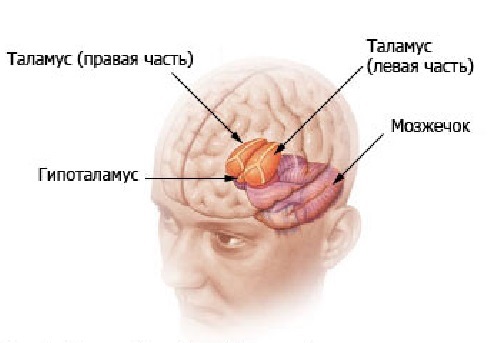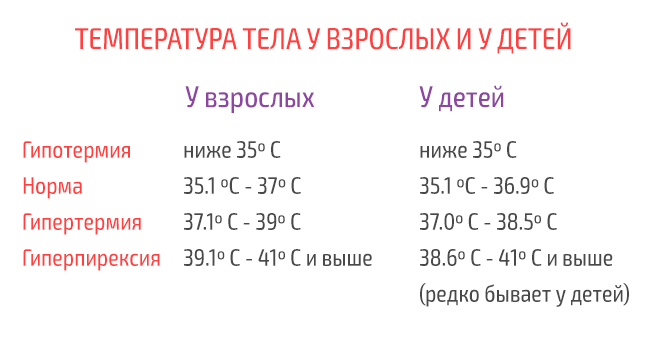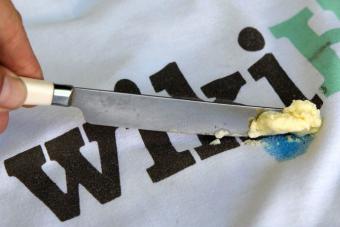What is the normal body temperature for a healthy person? What is dangerous low or high body temperature? What causes rise and fall in body temperature? When should you see a doctor?
The optimal time for measuring the normal body temperature of an adult healthy person is the middle of the day, while before and during measurements, the subject should be at rest, and the microclimate parameters should be within the optimal range. Even under these conditions, the temperature in different people may vary slightly, which may be due to age and gender.
During the day, the metabolic rate changes, and with it the temperature at rest changes. During the night, our bodies cool down, and in the morning the thermometer will show the minimum values. By the end of the day, the metabolism accelerates again, and the temperature rises by an average of 0.3-0.5 degrees.
In any case, normal body temperature should not fall below 35.9°C and rise above 37.2°C.
Very low body temperature
A body temperature below 35.2°C is considered very low. Among possible causes hypothermia can be called:
- Hypothyroidism or underactive thyroid. The diagnosis is established on the basis of blood tests for the content of hormones TSH, svt 4, svt 3. Treatment: prescribed by an endocrinologist (hormone replacement therapy).
- Violation of thermoregulation centers in the central nervous system. This can happen with injuries, tumors and other organic brain damage. Treatment: elimination of the cause of brain damage and rehabilitation therapy after injuries and surgical interventions.
- Decreased heat production by skeletal muscles, for example, in violation of their innervation as a result of a spinal injury with damage to the spinal cord or large nerve trunks. Decrease muscle mass due to paresis and paralysis can also lead to a decrease in heat production. Treatment: drug treatment is prescribed by a neurologist. In addition, massage, physiotherapy, exercise therapy will help.
- Prolonged fasting. The body simply has nothing to produce heat from. Treatment: restore a balanced diet.
- Dehydration of the body. All metabolic reactions take place in the aquatic environment, therefore, with a lack of fluid, the metabolic rate inevitably decreases, and the body temperature drops. Treatment: timely compensation of fluid losses during sports, when working in a heating microclimate, with gastrointestinal diseases accompanied by vomiting and diarrhea.
- organism. At very low ambient temperatures, thermoregulatory mechanisms may not be able to cope with their function. Treatment: gradual warming of the victim from the outside, hot tea.
- Strong alcohol intoxication. Ethanol is a neurotropic poison that affects all brain functions, including thermoregulatory. Help and treatment: call an ambulance. Detoxification measures (gastric lavage, intravenous infusions of saline), the introduction of drugs that normalize the function of the nervous and cardiovascular systems.
- The effect of elevated levels of ionizing radiation. The decrease in body temperature in this case is a consequence of metabolic disorders as a result of the action of free radicals. Assistance and treatment: detection and elimination of sources of ionizing radiation (measurement of the levels of radon isotopes and DER of gamma radiation in residential premises, labor protection measures in the workplace where radiation sources are used), treatment is prescribed after confirmation of the diagnosis (drugs that neutralize free radicals, restorative therapy),
With a decrease in body temperature to 32.2 ° C, a person falls into a state of stupor, at 29.5 ° C - loss of consciousness occurs, when cooled below 26.5 ° C, the death of the body most likely occurs.
moderate low temperature
Moderately reduced body temperature is considered to be in the range from 35.8 ° C to 35.3 ° C. The most likely causes of mild hypothermia are:
- , asthenic syndrome or seasonal. Under these conditions, a deficiency of some micro and macro elements (potassium, calcium, phosphorus, sodium, chlorine, magnesium, iron) can be detected in the blood. Treatment: normalization of nutrition, taking vitamin and mineral complexes, adaptogens (immunal, ginseng, Rhodiola rosea, etc.), fitness classes, mastering relaxation methods.
- Overwork due to prolonged physical or mental stress. Treatment: adjustment of the regime of work and rest, intake of vitamins, minerals, adaptogens, fitness, relaxation.
- Wrong, unbalanced diet for a long time. Hypodynamia exacerbates the decrease in temperature and helps to slow down metabolic processes. Treatment: normalization of the diet, proper diet, balanced diet, intake of vitamin-mineral complexes, increased physical activity.
- Hormonal changes during pregnancy, menstruation, menopause, decreased thyroid function, adrenal insufficiency. Treatment: prescribed by a doctor after determining the exact cause of hypothermia.
- Taking drugs that reduce muscle tone, such as muscle relaxants. In this case, skeletal muscles are partially switched off from thermoregulation processes and produce less heat. Treatment: contact your doctor for advice on possible drug changes or interruptions.
- Violation of liver function, leading to a change in carbohydrate metabolism. The condition will help to detect a general blood test, a biochemical blood test (ALAT, ASAT, bilirubin, glucose, etc.), ultrasound of the liver and bile ducts. Treatment: prescribed by a doctor after appropriate diagnostic procedures. Drug therapy aimed at the cause, detoxification measures, taking hepatoprotectors.
Subfebrile body temperature
This is a slight increase in body temperature when its values are in the range of 37 - 37.5 ° C. The cause of such hyperthermia can be completely harmless external influences, common infectious diseases and diseases that pose a serious threat to life, such as:
- Intensive sports or heavy physical labor in a warm microclimate.
- Visiting the sauna, bath, solarium, taking a hot bath or shower, some physiotherapy procedures.
- Eating hot and spicy foods.
- Acute respiratory viral infections.
- (the disease is accompanied by an increase in thyroid function and an acceleration of metabolism).
- Chronic inflammatory diseases (ovarian inflammation, prostatitis, gum disease, etc.).
- Tuberculosis is one of the most dangerous causes of a frequent increase in body temperature to subfebrile values.
- Oncological diseases - pose a serious threat to life and often lead to a slight increase in body temperature in the early stages of development.
If the temperature does not exceed 37.5 ° C, you should not try to reduce it with the help of medications. First of all, you need to consult a doctor so that the overall picture of the disease is not “blurred”.
If the temperature does not return to normal for a long time or subfebrile episodes are repeated every day, you should definitely go to the doctor, especially if it is accompanied by weakness, unexplained weight loss, swollen lymph nodes. After carrying out additional methods of examination, more serious health problems may be detected than you think.
Febrile temperature
If the thermometer shows 37.6 ° C or higher, then in most cases this indicates the presence of an acute inflammatory process in the body. The focus of inflammation can be localized anywhere: in the lungs, kidneys, gastrointestinal tract, etc.
In this case, most of us try to immediately bring down the temperature, but such a treatment tactic does not always justify itself. The fact is that an increase in body temperature is a natural protective reaction of the body, aimed at creating conditions unfavorable for the life of pathogens.
If a sick person does not have chronic diseases and if the fever is not accompanied by convulsions, then it is not recommended to reduce the temperature to 38.5 ° C with medication. Treatment should begin with plenty of fluids (1.5 - 2.5 liters per day). Water helps to reduce the concentration of toxins and their removal from the body with urine and sweat, as a result, the temperature drops.
At higher thermometer readings (39 ° C and above), you can start taking antipyretics, that is, drugs that reduce the temperature. Currently, the range of such drugs is quite large, but perhaps the most famous drug is aspirin, made on the basis of acetylsalicylic acid.
How does the temperature rise?
What is the mechanism for this?
How do antipyretics work?
 If you visually imagine the human brain, then exactly between the hemispheres and just below will be the diencephalon. One of its zones is called the hypothalamus. It is the hypothalamus that regulates your homeostasis, and with it the temperature (in addition to hundreds of other important processes for the body). Nearby is still such a brain appendage as the pituitary gland and these 2 friends - do not spill water, together they control most of your hormones and nerves throughout the body.
If you visually imagine the human brain, then exactly between the hemispheres and just below will be the diencephalon. One of its zones is called the hypothalamus. It is the hypothalamus that regulates your homeostasis, and with it the temperature (in addition to hundreds of other important processes for the body). Nearby is still such a brain appendage as the pituitary gland and these 2 friends - do not spill water, together they control most of your hormones and nerves throughout the body.
The hypothalamus has a kind of “normal temperature set point”: someone has 36.6, someone has 36.4, and someone has 36.8.
This was the introduction
Now about the very mechanism of temperature increase from the "start" - provocateur - reaction-processes-result.
Imagine a hypothetical situation that Carlson, who lives on the roof, fell ill. It does not matter how - something has become inflamed, viruses or bacteria have settled. Let all sorts of gram-positive and gram-negative bacteria appear in Carlson's body. In the shell of these bacteria there are substances that our immune cells (very different) recognize as foreign and dangerous. When our immune cells make their way through the bloodstream or between the cells of the body and look for saboteurs, they try to beat them somehow - surround and "eat", damage, "bite off" a piece, set something else, etc. When the stage of “dismemberment” of the enemy begins, it recognizes what the enemy consists of in order to give a signal further - to call ultra special immune cells or independently “remember” what kind of enemy it is for the future or transmit information somehow further, through a cascade of reactions. Most of the walls of bad bacteria are made up of substances that our immune cells have been able to recognize as bad since they were born. When they meet these substances, they synthesize their own - interleukin -1 alpha, interleukin 1 - beta, interleukin-6, in the case of non-bacteria "tumor necrosis factor", gamma - interferon, etc. Conditional Interleukin -1 enters the hypothalamus zone, its receptors (neurons) recognize it and this gives a signal: “aaaaaa, we have a saboteur here, spies brought news, the saboteur needs to be killed, we increase the temperature set point”
How does the body raise the temperature set point?
All these pyrogens, when they reach the hypothalamus, affect the synthesis of prostaglandins, and a large number of them trigger the synthesis of cyclic adenosine monophosphate (cAMP). (you don’t have to remember all this :))) The concentration of cAMP is the set point. If there is a lot of pyrogens = a lot of prostaglandin = a lot of cAMP = a higher temperature set point, which the body considers normal “for now” Less pyrogens = less prostaglandin = less cAMP = lower set point.
Here it is also important to explain about cAMP itself and the mechanism of raising the temperature. More cAMP - more calcium is thrown in for reactions that provide a change in temperature. Specifically, with Carlson's disease, it rises. How can you increase the body temperature? As in the economy, you need to either start earning more or save better. That is, either emit more heat or give less heat to the outside. In young children, the first way works more often - an increase in heat production, in adults the second way - the body begins to give off less of the created heat. The hypothalamus, through its functions, affects the vessels and contraction of skeletal muscles (calcium is needed for this), and this affects the maintenance of the temperature level. Children are less likely to have a chill stage and immediately begin to produce heat, adults turn into pale zombies (the arterioles narrow so as not to give off heat) and go through the chill stage (muscle microcontractions). There are not just hundreds, but thousands of reactions and processes on which notes are not enough.
Now about antipyretics
All of them work as antipyretics due to the fact that they block some reactions with the cyclooxygenase enzyme, there is no enzyme or a block on the enzyme in the reaction = less prostaglandins.
That is, like this: In the body there are 100 conventional units of bad substances, which should give 100 conventional prostaglandins, and those conventional 100 cAMP, which will raise the temperature level. In order for 100 bad ones to turn into 100 prostaglandins, 100 cyclooxygenases are needed. All antipyretics block the participation of cyclooxygenase. That is, we had 100 and the reaction should be 100, but 50 was blocked and the body received less information about the number of saboteurs and raises the temperature by 50% less than it should be.
This is all very exaggerated :) I don’t know how to explain it easier.
There are three types of cyclooxygenase enzymes - COX1, COX2, COX3. they are all +\- the same.
Paracetamol blocks COX3 and weakly blocks COX 1 and COX2.
ibuprofen and aspirin has a good effect on COX1 and COX2. Moreover, in small doses, aspirin blocks COX1 better.
Nimesil has a greater effect on COX2.
All meaning modern recommendations do not bring down the temperature to 38-39 not that a high temperature for a person will kill some bacteria or viruses. A temperature of 37-38 not only kills, but slows down the reproduction of some bacteria and viruses. The meaning of the recommendations not to shoot down is that if the body knows “the real state of affairs in terms of the number of enemies”, it can itself issue the necessary weapon - interferons, etc. But if we do not give the signal "a lot of enemies" at a time when there are really a lot of them, then there will be "little weapons" from the immune system, because it "thinks" that everything is ok.
And yet, the higher the temperature, the better the permeability of cell membranes, tissues, BBB barriers, the faster the reactions-transfers, the better and faster the drugs get to the right places.
(With) Julia Shulimova
“Normal” body temperature is considered to be a temperature of 36.6 ° C, however, in fact, each person has his own individual temperature norm in the average range from 35.9 to 37.2 ° C. This personal temperature is formed by about 14 years for girls and 20 for guys, and it depends on age, race, and even ... gender! Yes, men are on average half a degree "colder" than women. By the way, during the day the temperature of every absolutely healthy person makes a slight fluctuation within half a degree: in the morning the human body is colder than in the evening.
When to run to the doctor?
Deviations in body temperature from the norm, both upward and downward, are often a reason to consult a doctor.
Very low temperature– 34.9 to 35.2 °C – talking about:
As you can see from this list, any of the reasons described suggests an urgent visit to the doctor. Even a hangover, if it is so severe, should be treated with a course of droppers that will help the body get rid of the toxic breakdown products of alcohol faster. By the way, thermometer readings below the specified limit is already a direct reason for an urgent call for an ambulance.
Moderate drop in temperature – 35.3 to 35.8 °C – may refer to:
In general, a constant feeling of chilliness, cold and damp palms and feet is a reason to see a doctor. It is quite possible that he will not find any serious problems with you, and will only recommend “improving” nutrition and making the daily routine more rational, including moderate physical activity and increasing sleep duration. On the other hand, it is likely that the unpleasant chill that torments you is one of the first symptoms of a formidable disease that needs to be treated right now, before it has time to develop complications and go into the chronic stage.
Normal temperature - from 35.9 to 36.9°C - says that you do not suffer from acute diseases at the moment, and your thermoregulation processes are normal. However, not always normal temperature combined with the ideal order in the body. In some cases, with chronic diseases or reduced immunity, temperature changes may not occur, and this must be remembered!
Moderately elevated (subfebrile) temperature - from 37.0 to 37.3°C – it is the boundary between health and disease. May refer to:
However, such a temperature may also have absolutely “painful” reasons:
- bath or sauna visit, hot bath
- intense sports training
- spicy food
In the case when you didn’t exercise, didn’t go to the bathhouse, and didn’t have dinner at a Mexican restaurant, and the temperature is still a little elevated - you should go to the doctor, and it’s very important to do this without taking any antipyretic and anti-inflammatory drugs - firstly , at this temperature they are not necessary, and secondly, medications can blur the picture of the disease and prevent the doctor from making a correct diagnosis.
Heat – 37.4-40.2°C – indicates an acute inflammatory process and the need for medical attention. The question of whether to take antipyretic drugs in this case is decided individually. It is widely believed that temperatures up to 38 ° C cannot be “knocked down” - and in most cases this opinion is true: the proteins of the immune system begin to work in full force precisely at temperatures above 37.5 ° C, and the average person without severe chronic diseases is able to additional harm to health to endure temperatures up to 38.5 ° C. However, people suffering from certain neurological and mental illnesses should be careful: high fever can cause convulsions in them.
Temperatures above 40.3°C are life threatening and require emergency medical attention.
Some interesting facts about temperature:
- There are foods that reduce body temperature by almost a degree. These are green varieties of gooseberries, yellow plums and cane sugar.
- In 1995, scientists officially recorded the lowest "normal" body temperature - in a completely healthy and perfectly feeling 19-year-old Canadian, it was 34.4 ° C.
- Known for their extraordinary therapeutic findings, Korean doctors have come up with a way to treat seasonal autumn-spring depression, which many people suffer from. They suggested lowering the temperature of the upper body while raising the temperature of the lower half. In fact, this is a well-known health formula “Keep your feet warm and your head cold”, but doctors from Korea say that it is also applicable to improve a mood stubbornly striving for zero.
We measure correctly!
However, instead of panicking about abnormal body temperature, you should first think about whether you are measuring it correctly? A mercury thermometer under the arm, familiar to everyone since childhood, does not give the most accurate results.
Firstly, it is still better to purchase a modern, electronic thermometer, which allows you to measure the temperature with an accuracy of hundredths of a degree.
Secondly, the place of measurement is important for the accuracy of the result. The armpit is convenient, but due to a large number sweat glands - inaccurate. The oral cavity is also convenient (just remember to disinfect the thermometer), but you must remember that the temperature there is approximately half a degree higher than the temperature in the armpit, in addition, if you ate or drank something hot, smoked or have consumed alcohol, readings may be falsely high.
Measuring the temperature in the rectum gives one of the most accurate results, it should only be taken into account that the temperature there is about a degree higher than the temperature under the arm, in addition, the thermometer readings may be false after sports training or taking a bath.
And, the “champion” in terms of the accuracy of the result is the external auditory canal. It is only necessary to remember that measuring the temperature in it requires a special thermometer and precise observance of the nuances of the procedure, the violation of which can lead to erroneous results.
Temperature(from Lat. temperatura - proportionality, normal state) is a physical quantity that characterizes the state of thermodynamic equilibrium of the system. If the system is not in equilibrium, then heat exchange occurs between its parts that have different temperatures. A higher temperature is possessed by those substances in which the average kinetic energy of the molecules is higher. That is, the temperature quantitatively characterizes the measure of the average kinetic energy of the thermal motion of the molecules of a substance.
It follows from the definition of temperature that it cannot be measured directly and it can only be judged by a change in the physical properties (volume, electrical resistance, radiation intensity, etc.) of special instruments - thermometers. When taking measurements, it should be remembered that any thermometer always measures its own temperature. When thermodynamic equilibrium occurs between the thermometer and the body under study, the thermometer shows not only its own temperature, but also the temperature of the body under study.
Normal temperature of various organs and tissues
human body temperature- this is a balance between the formation of heat in the body (as a product of all metabolic processes in the body) and the release of heat through the surface of the body, especially the skin (up to 90-95%), as well as through the lungs, feces and urine.
Heat generation occurs in all organs and tissues, but not equally intense. Functionally active tissues and organs (eg, muscles, liver, kidneys) produce more heat than less active ones (connective tissue, bones). Heat loss by organs and tissues depends to a large extent on their location. The superficially located skin and skeletal muscles give off more heat and cool more than the internal organs.
From this it is clear that the temperature of different organs is different. Thus, the liver, located inside the body and giving greater heat production, has a higher temperature (38 degrees) compared to the skin, the temperature of which is much lower (especially in clothing-covered areas) and depends on the environment.
Moreover, different parts of the skin have different temperatures. Usually the skin of the head, trunk and upper extremities is 5-7 degrees warmer than the skin of the feet, the temperature of which varies between 24-35 degrees. The temperature may be different in the left and right armpits, the bowl on the left is 0.1-0.3 0 C higher.
Normal body temperature in the armpit: 36.3-36.9 0 C.
Normal body temperature in the oral cavity: 36.8-37.3 0 C.
Normal body temperature in the rectum: 37.3-37.7 0 C.
Physiological fluctuations in body temperature
Body temperature is not a constant value. The temperature value depends on:
Time of day. The minimum temperature is in the morning (3-6 hours), the maximum - in the afternoon (14-16 and 18-22 hours). Night workers may have the opposite relationship. The difference between morning and evening temperature in healthy people does not exceed 1 0 C.
motor activity. Rest and sleep help to lower the temperature. Immediately after eating, there is also a slight increase in body temperature. Significant physical stress can cause a temperature rise of 1 degree.
As already mentioned, the most intense heat generation in the body occurs in the muscles. A small physical activity leads to an increase in heat generation by 50-80%, and heavy muscle work - by 400-500%. In cold conditions, heat generation in the muscles increases, even if the person is stationary. This is due to the fact that the low ambient temperature, acting on receptors that perceive cold irritation, reflexively excites chaotic involuntary muscle contractions, manifested in the form of tremors (chills). At the same time, the metabolic processes of the body are significantly enhanced, the consumption of oxygen and carbohydrates by muscle tissue increases, which entails an increase in heat generation. Even arbitrary shaking increases heat generation by 200%.
Phases of the menstrual cycle. In women with a normal temperature cycle, the morning vaginal temperature curve has a characteristic biphasic shape. The first phase (follicular) is characterized by a low temperature (up to 36.7 degrees), lasts about 14 days and is associated with the action of estrogens. The second phase (ovulation) is manifested by a higher temperature (up to 37.5 degrees), lasts about 12-14 days and is due to the action of progesterone. Then, before menstruation, the temperature drops and the next follicular phase begins. The absence of a decrease in temperature may indicate fertilization. Characteristically, the morning temperature, measured in the axilla, in the oral cavity, or in the rectum, gives similar curves.
Deviations from the norm
- Hypothermia
- hyperthermia
- Fever
Hypothermia- this is a condition in which the body temperature under the influence of external factors drops below 35 degrees. Hypothermia occurs most rapidly when immersed in cold water. With hypothermia, a state similar to anesthesia is observed: the disappearance of sensitivity, the weakening of reflex reactions, the decrease in the excitability of the nerve centers and the intensity of metabolism, the slowing of breathing and heart rate, the decrease in cardiac output and blood pressure.
Short-term and not excessively intense effects of cold do not cause changes in the body's heat balance and do not lead to hypothermia. But they help develop colds and exacerbation of chronic inflammatory processes. In this regard, the hardening of the body acquires an important role. Hardening is achieved by repeated exposure to low temperatures of increasing intensity. In weakened people, hardening should begin with neutral temperature water procedures (32 degrees) and lower the temperature by 1 degree every 2-3 days. Unfortunately, the hardening effect disappears after the cessation of training, so the hardening regimen must be continuous. The hardening effect is manifested not only during water procedures, but also when exposed to cold air. At the same time, hardening occurs faster if the exposure is combined with active muscular activity (for example, exercise in the fresh air).
Hyperthermia- this is a condition in which the body temperature rises above 37 degrees (when measured in the armpit). It occurs with prolonged exposure high temperature environment, especially in humid air (e.g. heat stroke). Fever should be distinguished from hyperthermia - an increase in temperature, when external conditions are not changed, but the body's thermoregulation process is disturbed.
Fever- this is a protective and adaptive reaction of the body that occurs in response to the action of stimuli (often infectious) and is expressed in the restructuring of thermoregulation to maintain a higher than normal level of heat content and body temperature. The temperature during infectious fever usually does not exceed 41 0 C, in contrast to hyperthermia, in which it is higher than 41 0 C (for more details, see the file "Fever").
Temperature registration
The thermometer readings are recorded on the temperature sheet, where the dots indicate the morning and evening temperatures. Based on the marks made over several days, a temperature curve is obtained, which has a characteristic appearance in certain pathological conditions.
The temperature sheet may contain other information: heart rate, blood pressure, respiratory rate, with diarrhea - the number of bowel movements, periodically (once every 5-10 days) body weight, the number of red blood cells, white blood cells, hemoglobin level, ESR, etc. d.
Sources
- Gurevich-Ilyin G.Ya. General medical technology: A Practical Guide for Physicians and Medical Students. - M.: "Medgiz", 1946. - 436 p.
- Murtha J. General Practitioner's Handbook. Per. from English. - M.: "Practice", 1998. - 1230 p.
- Pavelski S., Zawadzki Z. Physiological constants in the clinic of internal diseases. Per. from Polish. M.I. Salman. - M.: "Medicine", 1964. - 264 p.
- Propaedeutics of internal diseases. Ed. V.Kh. Vasilenko, A.L. Grebnev. - 2nd ed., revised. and additional - M.: "Medicine", 1982. - 640 p.
Did you know that normal human body temperature is also called normothermia? It can be measured in the mouth, in the ears, in the armpit, or rectally. The result depends on the location. A role is also played by age, the level of activity of a person, and in women, the stage of the menstrual cycle.
A few facts:
- The temperature may change during the day.
- The temperature may be too low, or it may rise above normal.
- A temperature above 38°C most often means that you have a fever caused by an infection.
- Normal temperature ranges from 36.5°C to 37.5°C.
- Depending on the part of the body in which you measure the temperature, thermometers will also differ.
What is the normal temperature for a baby?
In the first months of life, the temperature fluctuates around 36°C - 38°C.
What is the normal body temperature for a child?
On average, the normal body temperature of a child is about 37°C. Usually in the morning - 36.3 ° C, and in the evening - up to 37.6 ° C.
What is the normal body temperature for adults?
In the mouth - 36.8 ° C.
In the armpit - 36.5 ° C.
Rectal or ear temperature - 37.5°C.

At what temperature does fever start?
The American Academy of Pediatrics insists that any temperature that rises above normal is considered a fever.
What is basal body temperature?
Basal temperature is the lowest temperature that is reached during rest, sleep. Basal temperature should be measured immediately after waking up, but even then it will be higher than during sleep. In women, basal temperature differs in different periods menstrual cycle. It can be used to track ovulation in order to avoid or promote pregnancy.
What is core temperature?
This is the working temperature of the body, which refers to certain organs, such as the liver. This temperature will be different from normal, as it is maintained within a narrow range of the body.
What is hyperpyrexia?
This is the name of the fever with the highest temperature indicators. They can even exceed 41.5°C.
What is hyperthermia?
High temperature, which is not as dangerous as the one we talked about above. The causes of hyperthermia can be heat stroke, reactions to medications, stimulants.
What is hypothermia?
Decreased body temperature below 35°C. It can be caused by hypothermia or fatigue.
As you can see, the temperature has many different indicators and values that really affect the state of health. To avoid problems, you should take your temperature whenever you feel unwell. If the readings are above or below average, then consult a doctor!
Marketium - positive, inspiration and life hacks
Click Like, →
to get the best
Facebook posts.
The content of this Site, such as the articles, text, graphics, images and other materials posted on this Site ("Content"), is for informational purposes only. No representations or warranties, express or implied, of completeness, accuracy, reliability, suitability or availability, for any purpose, are made with respect to the Content posted on this Site. Any use of the Content is at your own risk. The Content should not be construed as professional advice on legal, medical, financial, family matters, risk management or any other professional advice. If you require any specific advice, please consult a licensed or expert in the relevant field. The Publisher is not responsible for any injury or damage to the reader that may result from the reader acting on or using the Content contained on this Site.





